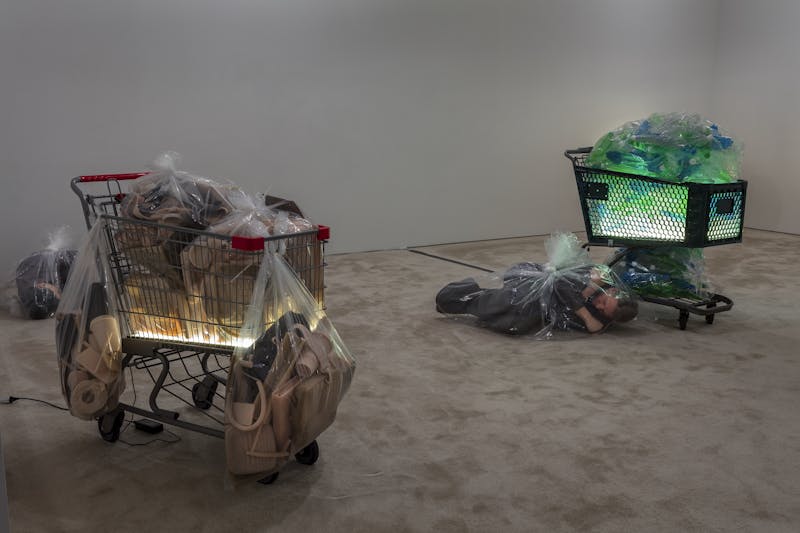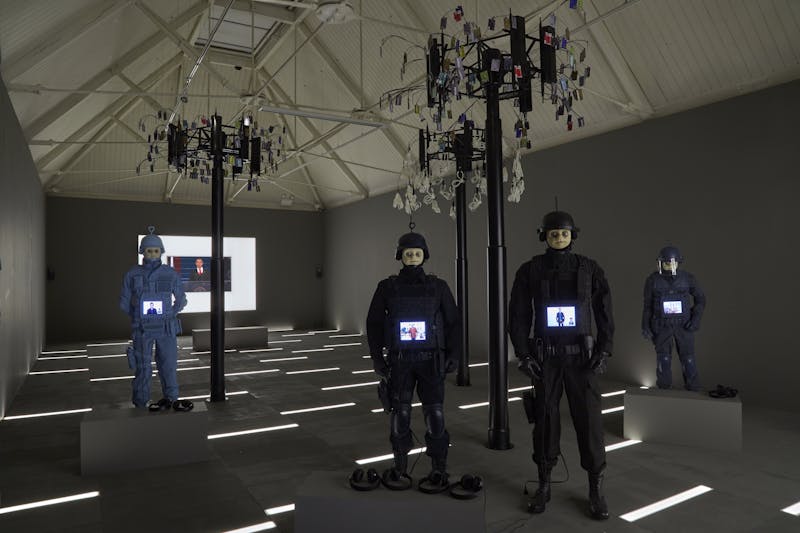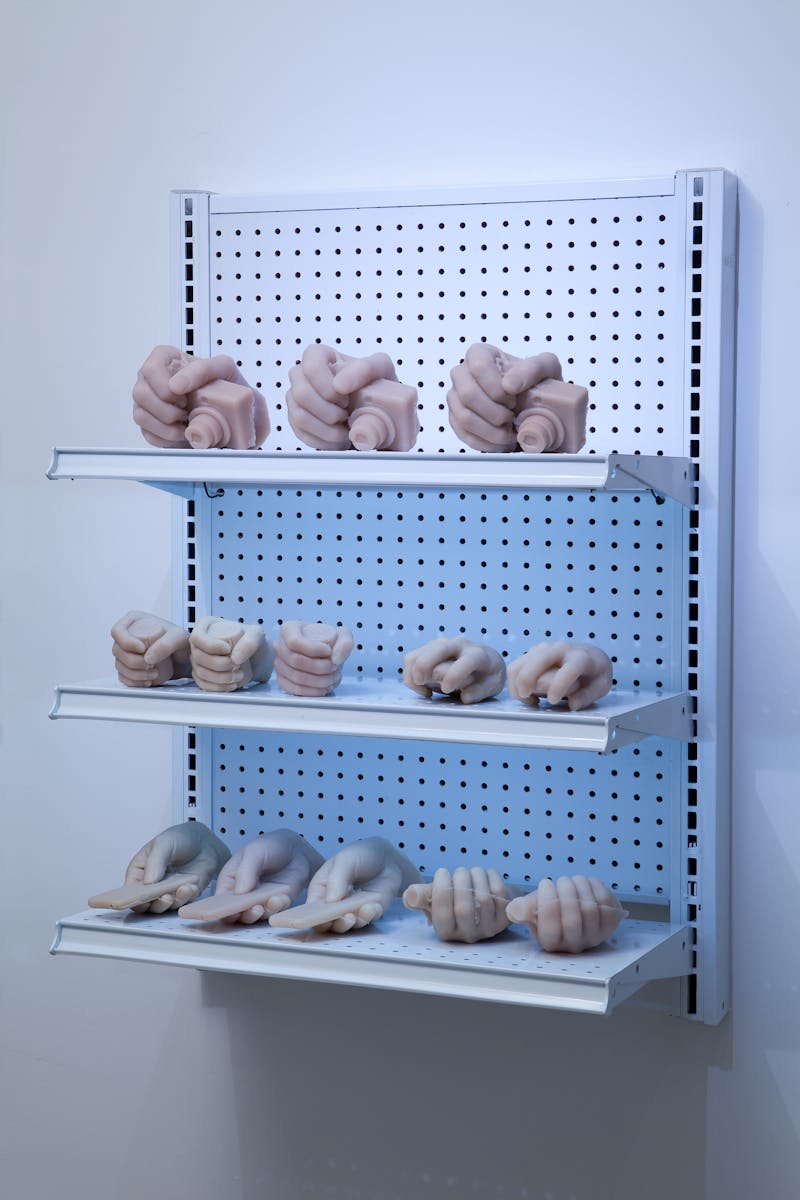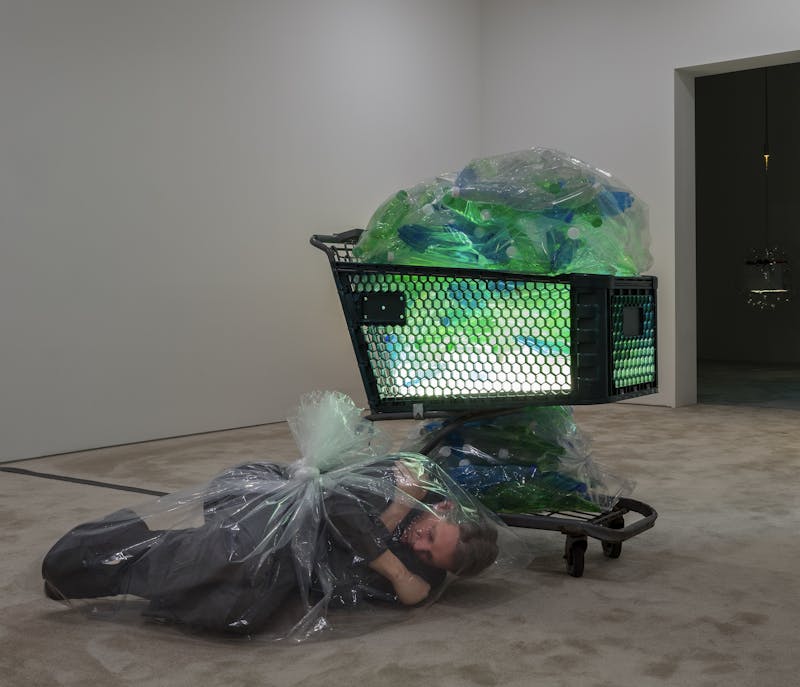
As Josh Kline sees it, we are living at the twilight of capital. His work as an artist continually returns to the ways people lose their humanity in a brutal and bifurcated economic system—from IV bags filled with a mixture of Redbull, Yerba Mate, Provigil, and gasoline to 3D prints of hotel janitors’ appendages fused to cleaning products. With a cheap budget and a black sense of humor, Kline has managed to establish himself as the art-world’s conscience, and yet this willingness to speak truth to power has helped launch his career: In the past two years his art has been acquired by the MoMA, Whitney, and exhibited across the globe. Freedom, which featured a Teletubby SWAT team with TVs embedded in their chests, was the critical darling of the 2015 New Museum Triennial. While Kline has the art-world’s attention, he believes it is his obligation to speak forcefully, and to connect with an audience beyond New York’s collectors and cool kids. With his alternately vital and disconcerting sculptures, videos, and installations presented in Unemployment, his latest show at 47 Canal, Kline has done just that.

Kline’s vision is more sardonic than apocalyptic. His work revels in undermining the aesthetics of brands like CVS, BluePrint juice, or Apple, and in skewering the people who love them. In 2011, Kline’s first solo show, Dignity and Self-Respect, focused on New York’s creative class—their desires, their habits, and their frailties. “Creative Hands” featured shelves of flesh-colored silicone casts made from the hands of Kline’s friends and acquaintances: A photographer cradling a digital camera, Kline’s gallerist at holding an Advil bottle, a fashion designer’s hand encased in a wrist brace. Together, they formed a pointed portrait of what creative labor looks like in the gig-based economy, with all its shortcuts and crutches.

“Skittles,” a 2014 installation on the Highline and perhaps his best-known work, is a glowing deli case filled with juices of Kline’s own devising, mixtures that represent various New York lifestyles. The juice’s otherworldly colors glow in the cold LED light, but the locked case keeps them just out of reach. Each flavor is labeled with a list of ingredients visible through the glass—a purple-white concoction, “Condo,” is made of coconut water, HDMI cable, infant formula, tumeric, yoga mat, and glass. The recipe is no joke: “I put yoga mats into the blender and blended them into a chunky powder,” he told me. These days, Kline isn’t as interested in lampooning the creative class, those adept at “self-branding, self-trafficking, and self-actualizing.” Instead he wants to expand his scope, “to look at the people being thrown away after they’ve been used up at work.”

Unemployment is set in the near future, sometime around 2030, when, according to the press release “intelligent software has turned out the lights on a hundred million jobs.” A vinyl chair stuffed with shredded tax documents, “On Layaway,” sits at the entrance to the gallery; beige carpeting runs the length of the space, giving way in a corner to Amazon Prime boxes fixed to the floor. Next to the cardboard tiles, a commercial for universal basic income called “ Universal Early Retirement” runs on a loop; it hits all the right notes, with the lens flares, diverse cast and upbeat hip-hop soundtrack of a Bernie Sanders ad. Across the space, banker boxes filled with office supplies and family photos hang inside hollow plastic viruses suspended from the ceiling.
The best pieces in the show aren’t representations so much as simulations. Kline’s sculptures of uncanny human forms wrapped in plastic occupy the center of the space. Newly fired or long out of work, their titles are a grim reminder of how capitalism makes even white collar workers disposable: “Productivity Gains,” “By Close of Business,” “Thank you for your years of service,” and “Aspirational Foreclosure.”
Kline hired casting agents to find the models, unemployed workers from the Baltimore area whose old jobs Kline predicts will be made unnecessary by automation. He chose Baltimore because he uses a commercial 3D-scanning company based there to capture his subjects’ every blotch and wrinkle. “It’s a metaphor for how we’re uploading our lives into all these corporate and government databases… you’re literally digitizing the topography and topology of their body,” says the artist. The level of detail, especially in the hands of these sculptures, approaches that of living human, and yet, their hair has the consistency of a Ken doll; the technology is still developing. “You still can’t scan hair,” he says. “It comes out looking like a Chia Pet.”

Across from the abandoned humans sits an orange shopping cart filled with bags of skin-colored silicone called “Desperation Dilation.” “There’s a Home Depot by my apartment in Brooklyn that’s particularly abject,” says Kline. A block away is a bottle recycling center, where people pushing carts filled with the recyclables from across the city converge to scrape out a living. Perhaps out of habit, I had imagined Kline was churning out his sculptures for Unemployment in a white studio with floor-to-ceiling windows, maybe located above a pastry shop in an expensive neighborhood. In reality, his studio is more modest. “Right now its in my kitchen, in Bed-Stuy,” he says.
Casual viewers might lump Kline’s work into the nascent category of “post-internet art,” a term used to describe contemporary art concerned with the increasing pervasiveness of technology. Often, post-internet art involves the materialization of the digital—think Richard Prince’s “New Portraits,” large-scale paintings of Instagram photos. Post-internet sculptures tend to be frontal in orientation, as if they were made not to be seen, but to be photographed and shared on social media. Kline hates this term and what it signifies. In his work, he believes “the internet is present—but it’s the tiniest background detail.” His practice is instead animated by the question: “What does today look like?” The internet happens to be a part of it.
Kline’s oeuvre may be future-oriented, but his values are the opposite of so many young artists working today, who have turned to celebrating the surfaces and tropes of digital technology and communication. The art collectives Dis, K-Hole, and The Jogging come to mind, each engaged in the mining, reproduction, and monetization of internet culture—Dis as fashion and lifestyle, K-Hole as corporate branding, The Jogging as all-consuming archive. Kline’s work engages in similar material, but always with the aim of pealing back the shiny facades of digital technologies rather than polishing them further. Instead of embracing the plugged in life, much of Kline’s work shows “creative labor’s role in creating a new kind of economy,” one that diminishes humanity for productivity.
Kline’s first two solo shows, Dignity and Self-Respect and Quality of Life, explored the lifestyle and lifecycle of celebrities from Kurt Cobain to Nicki Minaj, and Kline didn’t like what he found: He doesn’t have active Twitter or Facebook accounts and the text of his website is written in Latin. Whether Kline’s reticence is politically motivated given his interest in corporate and government surveillance, or just a kind of lifestyle choice, a digital colonic—it’s hard to tell. Sitting in the back room at 47 Canal, he seemed like he would rather use one of the saws hanging from the wall to hack off a limb than answer questions about his personal life. “I’m an artist, not an actor,” he says. Kline believes his life is boring, and would like to keep those boring details to himself. “What does it matter what color sweatshirt I’m wearing?” It was blue.